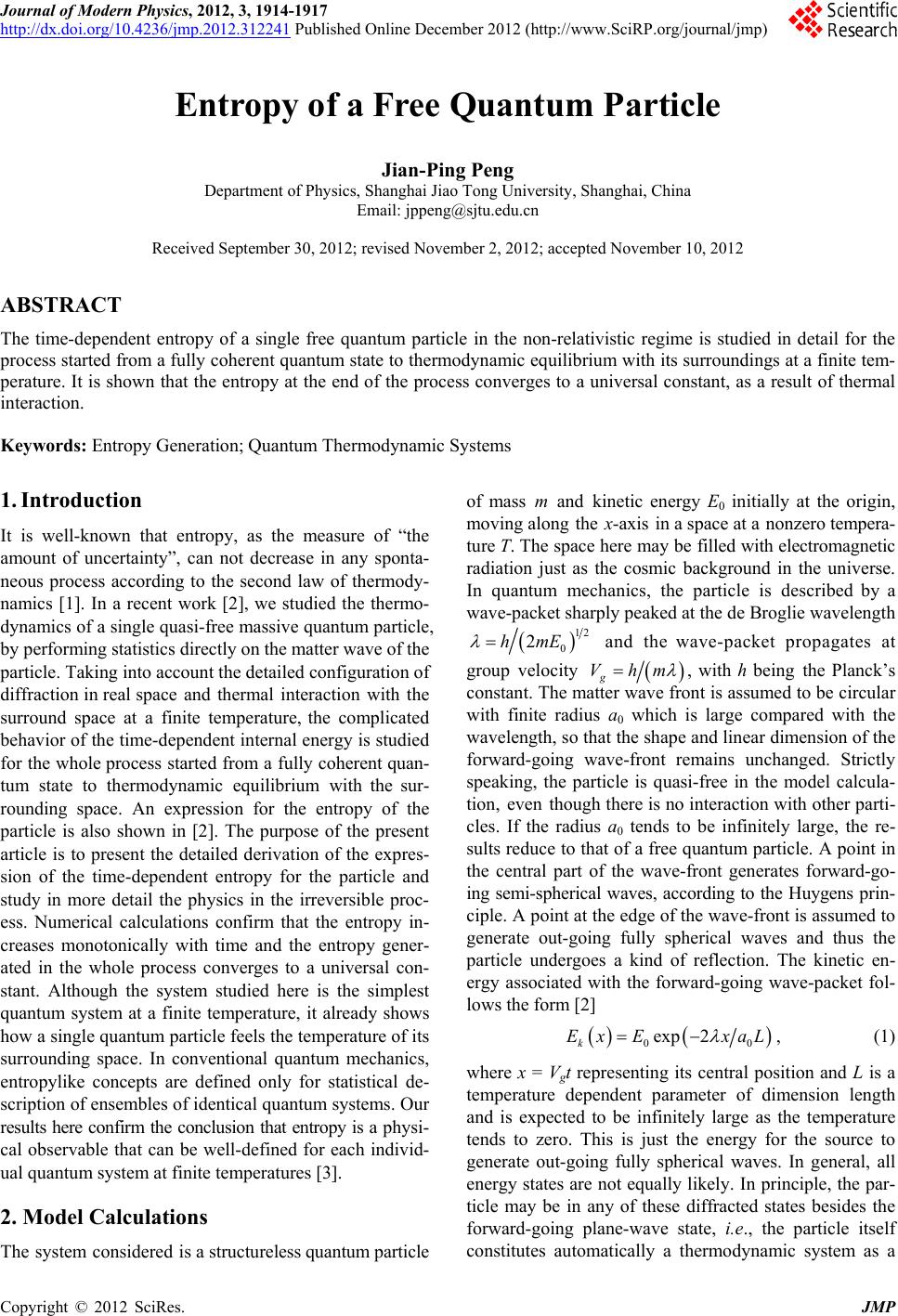
Journal of Modern Physics, 2012, 3, 1914-1917
http://dx.doi.org/10.4236/jmp.2012.312241 Published Online December 2012 (http://www.SciRP.org/journal/jmp)
Entropy of a Free Qu antum Particle
Jian-Ping Peng
Department of Physics, Shanghai Jiao Tong University, Shanghai, China
Email: jppeng@sjtu.edu.cn
Received September 30, 2012; revised November 2, 2012; accepted November 10, 2012
ABSTRACT
The time-dependent entropy of a single free quantum particle in the non-relativistic regime is studied in detail for the
process started from a fully coherent quantum state to thermodynamic equilibrium with its surroundings at a finite tem-
perature. It is shown that the entropy at the end of the process converges to a universal constant, as a result of thermal
interaction.
Keywords: Entropy Generation; Quantum Thermodynamic Systems
1. Introduction
It is well-known that entropy, as the measure of “the
amount of uncertainty”, can not decrease in any sponta-
neous process according to the second law of thermody-
namics [1]. In a recent work [2], we studied the thermo-
dynamics of a single quasi-free massive quantum particle,
by performing statistics directly on the matter wave of the
particle. Taking into account the detailed configuration of
diffraction in real space and thermal interaction with the
surround space at a finite temperature, the complicated
behavior of the time-dependent internal energy is studied
for the whole process started from a fully coherent quan-
tum state to thermodynamic equilibrium with the sur-
rounding space. An expression for the entropy of the
particle is also shown in [2]. The purpose of the present
article is to present the detailed derivation of the expres-
sion of the time-dependent entropy for the particle and
study in more detail the physics in the irreversible proc-
ess. Numerical calculations confirm that the entropy in-
creases monotonically with time and the entropy gener-
ated in the whole process converges to a universal con-
stant. Although the system studied here is the simplest
quantum system at a finite temperature, it already shows
how a single quantum particle feels the temperature of its
surrounding space. In conventional quantum mechanics,
entropylike concepts are defined only for statistical de-
scription of ensembles of identical quantum systems. Our
results here confirm the conclusion that entropy is a physi-
cal observable that can be well-defined for each individ-
ual quantum system at finite temperatures [3].
2. Model Calculations
The system considered is a structureless quantum particle
of mass m and kinetic energy E0 initially at the origin,
moving along the x-axis in a space at a nonzero tempera-
ture T. The space here may be filled with electromagnetic
radiation just as the cosmic background in the universe.
In quantum mechanics, the particle is described by a
wave-packet sharply peaked at the de Broglie wavelength
12
0
2hmE
and the wave-packet propagates at
g
Vhm
group velocity
, with h being the Planck’s
constant. The matter wave front is assumed to be circular
with finite radius a0 which is large compared with the
wavelength, so that the shape and linear dimension of the
forward-going wave-front remains unchanged. Strictly
speaking, the particle is quasi-free in the model calcula-
tion, even though there is no interaction with other parti-
cles. If the radius a0 tends to be infinitely large, the re-
sults reduce to that of a free quantum particle. A point in
the central part of the wave-front generates forward-go-
ing semi-spherical waves, according to the Huygens prin-
ciple. A point at the edge of the wave-front is assumed to
generate out-going fully spherical waves and thus the
particle undergoes a kind of reflection. The kinetic en-
ergy associated with the forward-going wave-packet fol-
lows the form [2]
00
exp 2
k
Ex ExaL
, (1)
where x = Vgt representing its central position and L is a
temperature dependent parameter of dimension length
and is expected to be infinitely large as the temperature
tends to zero. This is just the energy for the source to
generate out-going fully spherical waves. In general, all
energy states are not equally likely. In principle, the par-
ticle may be in any of these diffracted states besides the
forward-going plane-wave state, i.e., the particle itself
constitutes automatically a thermodynamic system as a
C
opyright © 2012 SciRes. JMP